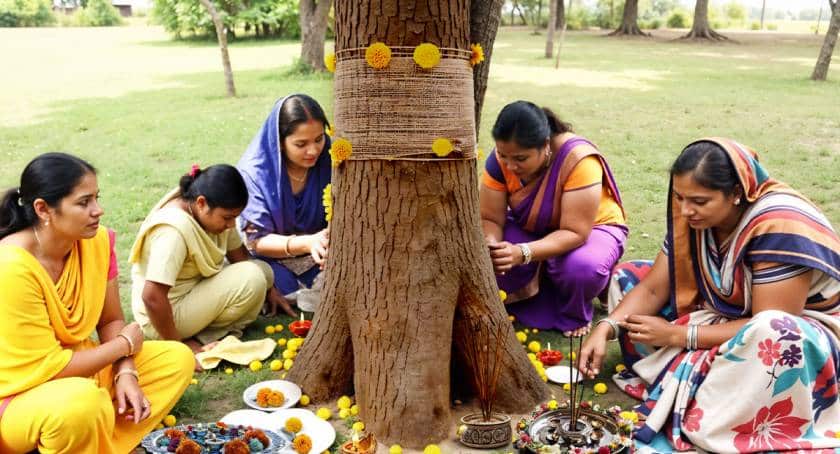Anla Navami: A Tribute to the Amla Tree
Odisha, a land steeped in spirituality and cultural vibrancy, has numerous festivals highlighting its rich traditions and religious fervor. Among these, Anla Navami is especially significant to married ladies since it is closely linked to the veneration of Lord Vishnu and the holy Anla (Amla) tree. Observed on the ninth day (Navami) of the Kartik month in the Hindu calendar, this festival is a unique blend of devotion, environmental reverence, and well-being. The rituals of Anla Navami are not just religious observances but also embody significant cultural and social values, reinforcing the spiritual connection between humans and nature.
The Significance of Anla Navami
Anla Navami derives its name from the Anla (Amla) tree, the Indian gooseberry. Hindu traditions regard the Anla tree as sacred and revere it for its numerous health benefits. Ayurvedic texts widely value the therapeutic qualities of amla and acknowledge it as a rich source of vitamin C, antioxidants, and nutrients that promote general health. Beyond its health benefits, the tree symbolizes purity, longevity, and spiritual awakening.
In Odisha, married women primarily observe Anla Navami by fasting and performing rituals to seek their husbands’ longevity, prosperity, and well-being. The festival is deeply connected to Lord Vishnu, as devotees believe that worshipping the Anla tree and the deity on this auspicious day can cleanse sins, bestow salvation, and bring divine blessings. Devotees also consider the festival a significant spiritual uplift day, encouraging them to engage in charity, devotion, and self-discipline.
Rituals and Observances of Anla Navami
Anla Navami is celebrated with immense devotion and involves a series of sacred rituals. Women enthusiastically prepare for the festival and ensure they conduct every aspect of the observance with purity and dedication.
- Early Morning Purification
An early morning purification ritual kicks off the day. Before dawn, women get up and bathe in a pond, river, or their own homes. This act of purification symbolizes the cleansing of both body and soul, preparing them for the sacred rituals of the day. Following the bath, ladies don traditional sarees, ideally in vibrant colors such as red and yellow, as these shades symbolize prosperity, joy, and good fortune.
- Fasting and Devotional Practices
Observing a fast is a crucial aspect of Anla Navami. Women undertake a strict fast throughout the day, refraining from consuming food and drinking only water or consuming fruits if necessary. The fast is broken only after the completion of the evening rituals. As an act of self-discipline and commitment, fasting strengthens one’s spirituality and shows one’s unwavering confidence in God.
- Worship of the Anla Tree
The highlight of Anla Navami is that devotees worship the Anla tree, believed to embody divine energy. Women gather around an Anla tree in groups and perform a special puja (ritualistic offering). People adorn the tree with turmeric, kumkum (vermilion), flowers, and sandalwood paste. During the worship, women circumambulate (parikrama) the tree, reciting sacred mantras and hymns dedicated to Lord Vishnu.
This ritual signifies the eternal bond between nature and humanity, emphasizing environmental conservation and the reverence of trees as sacred entities. The Anla tree, a health benefits storehouse, is also worshipped as a symbol of vitality and well-being.
- Recitation of the Anla Navami Katha (Legend)
During the puja, people read or narrate the Anla Navami Katha, a traditional legend associated with the festival. This story recounts the tale of a devoted woman who, by worshipping the Anla tree and offering prayers to Lord Vishnu, received divine blessings that ensured happiness and prosperity for her family. The narration of this fable motivates adherents and underscores the importance of faith, dedication, and piety.
- Offering Food to Brahmins and Seeking Blessings
A key part of the observance includes charitable acts, such as offering Brahmins and the underprivileged food. Women prepare unique dishes, including rice-based items, lentils, and sweets, and first offer them as prasad (holy offering) before distributing them. They also seek blessings from elders and priests, believing that this brings prosperity and good fortune to the family.
Anla Navami at the Jagannath Temple, Puri
The festival holds profound significance in Puri, particularly at the revered Jagannath Temple. On this special day, devotees receive the rare privilege of worshipping the feet of Lord Jagannath, a ritual not permitted on most other days. Thousands of worshippers crowd the temple grounds, ready to pray and ask for divine favors. This unique tradition amplifies the spiritual magnitude of Anla Navami, drawing pilgrims and devotees from across Odisha and beyond.
Cultural and Social Importance of Anla Navami
Beyond its religious aspects, Anla Navami strengthens social and cultural bonds. Women from various communities celebrate, share meals, and engage in collective prayers, making people feel more harmonious, courteous, and united.
The festival underscores the significance of environmental consciousness. By highlighting trees’ crucial role in supporting life, worshiping the Anla tree raises awareness about the need to save the environment. Devotees revere nature’s abundance and recognize the importance of maintaining ecological balance by respecting the Anla tree.
Final Thoughts
Anla Navami is a festival that beautifully intertwines spirituality, health, and cultural traditions. The festival reinforces faith, devotion, and family well-being through its sacred observances while encouraging environmental stewardship. As Odia women uphold this rich tradition, Anla Navami remains a timeless testimony to Odisha’s deep-rooted spiritual and cultural heritage.
With its blend of religious significance, social harmony, and ecological consciousness, Anla Navami continues to be a cherished occasion. It celebrates the divine bond between humanity, nature, and faith. May the blessings of Lord Vishnu and the sacred Anla tree bring prosperity, happiness, and good health to all. Celebrate this holy tradition with devotion and joy.


